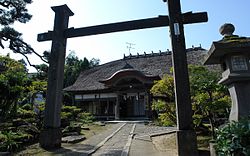Shukubo
In Japan, a Shukubo (宿坊) is a place where visitors can spend the night inside a Buddhist temple. It means "temple lodging" in English.[1] In the past, these facilities were built to house only monks and worshippers. However, nowadays, more and more of them are welcoming general tourists and expanding their facilities and services accordingly.[2][3][4] Some temples, such as Mount Kōya, have outdoor hot spring baths known as Onsens.[5] These temple lodgings are now somewhat secularized and in many towns, they are the only available accommodation options.[5]


History
changeAt first, only Buddhist monks called Bhikkhu were permitted to stay at these accommodations. However, during the Heian period, more individuals began to embark on pilgrimages to temples and shrines. As a result, even people like the nobility, samurai, and common pilgrims began to stay in these facilities. As a result, the operators of these facilities were no longer only monks.[2]
Shukubo were historically used by Shugendo practitioners and those who worshipped mountains. They played significant roles in the development of both practices.[6]
In a construction boom that lasted for several decades in the Edo period, networks of Shukubo started to develop in Ise, Shima, Toba, and Futami-ura.[7]
Many of the present-day operators of Shukubo are descendants of families who used to run them when they were solely for religious purposes. These Shukubo were originally intended for only one Kosha, but opening up to the general public has significantly increased the number of people staying at these facilities.[8]
At the base of Mount Haguro, there were once 336 Shukubo, all of which were connected to Shugendo.[9]
During the Edo period, visits to temples and shrines became popular Destinations included those Ise, Kotohira-gū, and Zenkō-ji. As a result, lodging houses were constructed at major temples and shrines in each area to accommodate ordinary pilgrims and tourists. This formed an early tourism industry. Specific areas were linked to specific lodging houses.
In modern times, some Shukubo have been transformed into traditional inns and ryokans for tourists who wish to experience the ambiance of a temple stay.[10]
Related pages
changeGallery
change-
Sakurahonbo
-
Vegetarian food at Hagurosan Saikan
-
Hagurosan Saikan Room
-
Inside the lodging house (corridor and rooms)
References
change- ↑ "Shukubo Japan - 10 Amazing Places To Experience Temple Lodging". Asian Wanderlust. 2019-09-18. Retrieved 2022-02-26.
- ↑ 2.0 2.1 "8 Recommended Shukubo (Temple Lodging) Spots Throughout Japan". tsunagu Japan. Retrieved 2022-09-21.
- ↑ "宿坊とは - 和空|寺社・宿坊に泊まる". 12 April 2018. Archived from the original on 2018-08-31. Retrieved 2019-10-18.
- ↑ "福智院公式サイト". Archived from the original on 2016-11-27. Retrieved 2019-10-18.
- ↑ 5.0 5.1 Reader, Ian (2020). "Turning to Tourism in a Time of Crisis?". Buddhist Tourism in Asia. University of Hawai'i Press. pp. 161–180. doi:10.2307/j.ctvgs09c4.13. ISBN 978-0-8248-8118-4. JSTOR j.ctvgs09c4.13.
- ↑ Kaminishi, Ikumi (2006). "Deciphering Mountain Worship". Explaining Pictures. University of Hawai'i Press. pp. 165–192. ISBN 978-0-8248-2697-0. JSTOR j.ctvvmxpt.12.
- ↑ Andreeva, Anna (2017). "From Ise to Miwa and Beyond". Assembling Shinto. Vol. 396. Harvard University Asia Center. pp. 175–214. doi:10.2307/j.ctv47w8vp.12. ISBN 978-0-674-97057-1. JSTOR j.ctv47w8vp.12.
- ↑ >Carter, Caleb (2018). "Power Spots and the Charged Landscape of Shinto". Japanese Journal of Religious Studies. 45 (1): 145–174. doi:10.18874/jjrs.45.1.2018.145-173. JSTOR 26854474.
- ↑ Earhart, H. Byron (1965). "Four Ritual Periods of Haguro Shugendō in Northeastern Japan". History of Religions. 5 (1): 93–113. doi:10.1086/462516. JSTOR 1061805.
- ↑ デジタル大辞泉,世界大百科事典内言及. "宿坊(シュクボウ)とは? 意味や使い方". コトバンク (in Japanese). Retrieved 2023-01-19.
Other websites
change- Media related to Shukubo at Wikimedia Commons